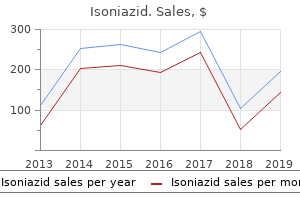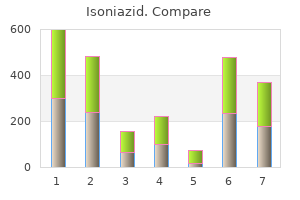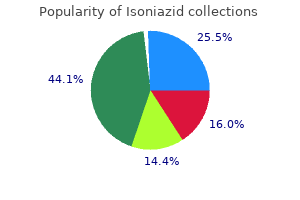"Cheap isoniazid 300mg without prescription, treatment question".
By: A. Grimboll, M.B. B.CH. B.A.O., M.B.B.Ch., Ph.D.
Deputy Director, Weill Cornell Medical College
Bone marrow hypoplasia has been noticed in some sufferers with lympho cytedepleted classic Hodgkin lymphoma in whom infiltration was not detected [495] treatment plant cheap isoniazid 300mg with visa. Following profitable remedy medicine reactions isoniazid 300 mg with amex, the lymphoma tous infiltrate disappears and reactive adjustments medications 142 generic 300 mg isoniazid with mastercard, together with fibrosis, regress. When only reticulin fibrosis is present full regression happens; when there was collagen deposition some sufferers present full regression and others partial. When suspicious features are present, immunohisto chemistry and typically examination of serial sec tions is indicated. Focal lesions are primarily ran domly distributed although some are paratrabecu lar [496,510]. Focal infiltration is commonest within the nodular sclerosis subtype, whereas the lympho cytedepleted subtype is characterized by diffuse infiltration. Focal lesions are inclined to be highly mobile with a blended infiltrate of small lymphocytes with variable numbers of eosinophils, plasma cells, mac rophages and Reed�Sternberg cells and their vari ants. Four pat terns can be acknowledged: 1 In the vast majority of sufferers, the marrow is hyper mobile with a combined cellular infiltrate as described above. Various combinations of these patterns could additionally be seen in the identical biopsy specimen or in several biopsy specimens from the same affected person. Problems and pitfalls Marrow infiltration by traditional Hodgkin lymphoma could be confused with infiltration by a peripheral Tcell lymphoma or a large Bcell lymphoma (particularly Tcell/histiocyterich giant Bcell lymphoma), both of which might have neoplastic cells resembling Reed�Sternberg cells. Immunohistochemical staining will often allow the proper analysis to be made. Primary myelofibrosis is well simulated since such sufferers usually have spleno megaly, pancytopenia and radiologically demon strable osteosclerosis. The massive neoplastic cells in basic Hodgkin lymphoma can sometimes be mis taken for megakaryocytes or carcinoma cells. Nodular lymphocytepredominant Hodgkin lymphoma Nodular lymphocytepredominant Hodgkin lym phoma is an uncommon Bcell neoplasm outlined by characteristic large neoplastic cells in an inflam matory background. Patients are more often male with a peak incidence between 30 and 50 years; median age of onset is a decade earlier in males [517]. Neoplastic cells can be rare in order that immunohistochemistry is required to highlight their presence [519]. Cytogenetic and molecular genetic analysis Immunoglobulin genes are clonally rearranged. Posttransplant and other immunodeficiency associated lymphoproliferative problems and their relationship to the Epstein�Barr virus Many of the entities already discussed have an elevated incidence in, or are largely confined to , immunodeficient individuals. Primary an infection usually occurs in childhood and, in the huge major ity of individuals, is asymptomatic. Epstein�Barr virus has been implicated in the pathogenesis of a selection of distinct types of lym phoma and nonneoplastic lymphoproliferative disorders [521] (Table 6. Posttransplant lymphoproliferative problems associated to immunosuppression have been observed notably following strong organ transplantation (renal, heart, heart/lung, thymus and liver) [522] and, to a lesser extent, following bone marrow transplantation [523]. The incidence following strong organ transplantation is expounded to the degree of immune suppression and, in some series of sufferers, has been as excessive as 20�25%. Following bone marrow transplantation, the cumu lative incidence is around 1% by 10 years with most instances occurring throughout the first 6 months [524]. The lymphoproliferative disorders observed vary from polyclonal through oligoclonal prolife rations to monoclonal lymphomas [528�531]. Lymphoproliferative disorders noticed posttrans plant are sometimes multifocal and extranodal. Polymorphic posttransplant lymphoproliferative disorder is characterized by a harmful infiltrate made up of a combined inhabitants of cells symbolize ing the total spectrum of Bcell maturation from immunoblasts to plasma cells [533].

The chromatin in the eryth roblast nuclei is evenly distributed and medications descriptions buy generic isoniazid 300 mg line, as chroma tin condensation happens medicine 853 purchase isoniazid in united states online, an even treatment multiple sclerosis purchase isoniazid paypal, regular sample is retained. There are four options which are helpful in distin guishing erythroid precursors within the marrow from different cells: (i) in normal bone marrow they happen in distinctive erythroblastic islands containing several generations of cells of varying size and maturity; (ii) erythroblasts adhere tightly to one another; (iii) their nuclei are round; and (iv) in late erythroblasts the chromatin is condensed in a regular method whereas nuclei of small lympho cytes present coarse clumping. When the bone marrow is regenerating rapidly, erythroid islands may be composed of cells all of that are on the identical stage of maturation. A related pattern is sometimes seen when erythropoiesis is irregular, for example in myelod ysplasia, during which the intramedullary demise of erythroblasts is a serious mechanism. It is extra irregular in shape than a proerythro blast and its cytoplasm is reasonably rather than strongly basophilic. Myeloblasts are generally defined as being cells that lack granules but, in the context of the abnormal myelopoiesis of acute myeloid leukaemia and the myelodysplastic syndromes, primitive cells with granules may be accepted as myeloblasts. They are fairly large cells with spherical to oval nuclei and one to five comparatively small nucleoli. They are readily distinguished from lymphoid cells by the absence of chromatin clumping and the presence of nucleoli. Granules of cells of eosinophil lineage are massive, refractile and extra strongly eosinophilic. As maturation happens, gran ulocytic precursors are found progressively extra deeply in the haemopoietic cords but away from the sinusoids. When they reach the metamyelocyte stage, they appear to move in path of the sinusoids and, at the polymorphonuclear granulocyte stage, cross the wall to enter the circulation. Their cytoplasm is much less basophilic than that of promyelocytes and specific neutrophilic, eosinophilic and basophilic granules can now be discerned, staining lilac, orangered and purple, respectively. Eosinophil myelocytes can also include some granules that take up basic dyes and stain purple; these differ ultrastructurally from the granules of the basophil lineage and are greatest designated proeosinophilic granules. There are in all probability normally no less than two generations of myelocytes so that at least some cells of this category are capable of cell division. The band cell, in turn, matures to a polymorphonuclear granulocyte with a segmented nucleus and specific neutrophilic, eosinophilic or basophilic granules. Alternatively, the id of cells of the granulocytic lineage may be confirmed by immunohistochemistry. Monocytopoiesis Cytology Monocytes are derived from a morphologically unrecognizable widespread granulocytic�monocytic precursor. The earliest morphologically recogniza ble precursor is a monoblast, a cell which is bigger than a myeloblast with plentiful cytoplasm present ing a variable degree of basophilia and with a big, spherical nucleus. Promonocytes mature into monocytes, which migrate rapidly into the periph eral blood. The cytoplasm could contain small numbers of fantastic azurophilic granules and sometimes has a groundglass appearance, in distinction to the clear cytoplasm of a lymphocyte. These are large cells, 20�30 �m in diameter, of irregular shape, with a low nucleocytoplasmic ratio and voluminous weakly basophilic cytoplasm. When comparatively immature, they might have an oval nucleus with a fairly diffuse chromatin sample. When mature, the nucleus is smaller and more condensed and the cytoplasm could include lipid droplets, recognizable degenerating cells and amor phous particles; an iron stain generally reveals the presence of haemosiderin. Bone marrow mac rophages might turn into various storage cells, which will be discussed in later chapters.

An alkylating agent can insert a single pair of bases right into a chromosome during the S phase treatment 1st degree burn buy discount isoniazid 300mg, and this trivial alteration can result in medications dispensed in original container buy isoniazid 300mg with visa a mutation [5] symptoms you have worms order 300mg isoniazid fast delivery. Thus, injury is repaired or severely damaged cells are eliminated, maintaining genomic stability. Cells with mutations on their approach to tumorigenesis usually avoid and disable the normal control mechanisms [7]. They also usually enhance their price of buying further mutations by increased sensitivity to mutagenic brokers. Progressive tumour improvement is characterised by increasing genomic instability with positive aspects and losses of gene copy numbers across the cell genome. This theory is supported by the epidemiological fact that the incidence of most forms of most cancers will increase dramatically with age. With normal cell cycle management mechanisms, the possibility improvement of multiple mutations takes many years, even a long time to occur. In precancerous lesions, a sequence of mutations, which regularly happen in a welldefined order, have been recognized. Inherited mutations � mutations in a germ line � will render an individual to have a mutated version of a gene in a single allele. The other allele may have a normal gene and normally this shall be adequate to stop cancer formation. Highly complex interacting pathways transmit intra and extracellular signals, which in cancer cells end in genetic changes that maintain and enhance steady proliferation. Therefore, these people might be at the next risk of most cancers growth than people with two regular alleles (hereditary predisposition). For a protooncogene to become an oncogene, a acquire offunction mutation is required by point mutation, localised reduplication (gene amplification), or chromosomal translocation. Gainoffunction mutations that convert a protooncogene into an oncogene act dominantly because just one allele needs to be affected for an abnormally excessive expression of the gene product to be expressed. Tumour suppressor genes encode proteins that control regular cell development and proliferation, and if they acquire mutations, cell cycle management is disturbed. Five courses of proteins are encoded by tumour suppressor genes: intracellular proteins which inhibit cell cycle development. These are lossoffunction mutations leading to an underexpression of the gene product. Because both alleles of the cell have to be affected for the gene product to be abnormally low or nonfunctional, mutations in tumour suppressor genes act recessively. In a somatic cell which accommodates a mutant tumour suppressor gene, the conventional allele will normally keep regular and practical expression of the encoded regulatory protein. This can happen through errors throughout mitosis involving the chromosomes (nondisjunction, mitotic recombination). There are many recognized effectors regulating cell cycle management which might turn into oncogenes or defective four. Thus, if each defects occur simultaneously, uncontrolled driving at excessive pace (proliferation) will happen. Normal tissues management the manufacturing and launch of growthpromoting alerts that provoke entry into the mitotic cycle, maintaining homeostasis and regular tissue architecture. The selling alerts are usually development components that bind to cellsurface receptors coupled to intracellular tyrosinekinase domains. These respond by sending indicators by way of intracellular signalling pathways that regulate the cell cycle. Some of this growthinducing signalling is affected by releasing development factors into the intercellular area and is transferred from cells to their neighbours (paracrine stimulation).

Once testosterone has subtle into the prostate and stromal epithelial cells treatment lead poisoning order isoniazid without a prescription, it binds to the androgen receptors medicine wheel images order isoniazid canada. Murine urogenital sinus mesenchyme cells will induce intact male murine bladder cells to proliferate medications qt prolongation buy generic isoniazid 300mg line, bud, and acquire a distinctly prostatic look when these cells are coincubated, this inductive process is androgen dependent, and it has been found that the stromal and epithelial cells are able to producing development factors. The peripheral zone makes up 70% of the prostate, whilst the central zone (20�25%) is the subsequent largest zone and is cone formed, with the base forming a lot of the base of the prostate and the apex positioned at verumontanum. The easy muscle tone is regulated by the adrenergic nervous system and receptorbinding research show the 1a is the most abundant adrenoceptor in the human prostate. As the stress within the prostatic capsule increases, the prostate assumes a more spherical shape, this being the shape with the lowest floor rigidity for a given quantity. This can then be adopted by decreased detrusor contractility, which manifests clinically by poor stream, hesitancy, intermittency, and increase in residual urine [19]. The texture of the wall of the bladder changes from a nice felt to a course web, by way of the gaps of which the urothelium bulges out. The interior of the bladder develops a charac- teristic trabeculated appearance with saccules and diverticula formation from the herniated urothelium. There is an increase in voiding pressure throughout the bladder, unwanted contractions happen irrespective of bladder filling, and detrusor instability, resulting in storage signs. Failure to relieve the outflow obstruction will eventually result in detrusor failure. Detrusor failure leads to lack of ability to empty the bladder completely, leading to residual urine that may give rise to problems. The urothelium is herniated between gaps in the trabeculae to kind saccules and diverticula. Stones that develop in residual urine both become rounded like pebbles or assume the traits of a Jackstone. This was linked to the truth that as men received older their comorbidities elevated contributing to the upper mortality rates (Table 27. Obviously, these sufferers have to be managed by inserting an indwelling urethral catheter, but one should be cautious about the potential of postobstructive diuresis, which may lead to dehydration and electrolyte disturbances due to lack of sodium. Close monitoring of renal operate and urine output are required as intensive fluid, and salt substitute may be indicated. Following the reduction of bilateral ureteric obstruction, tubular operate normally recovers inside two weeks, but full recovery of glomerular function could take up to three months. Age (years) Spontaneous acute retention Precipitated acute retention a) 45�54 55�64 65�74 75�84 >85 Any age b) 45�54 55�64 65�74 75�84 >85 Any age 1. While histological prevalence was more dramatic: <30 years (0%), 41�50 years (23%), 51�60 years (42%), 61�70 years (71%), 71�80 years (82%), and > 80 years (>88%) [28]. Studies of complete prostate quantity of males of their 30s revealed that total prostate volume averaged 25 cm3, and this elevated to 45 cm3 for males of their 70s. Elicitation of purple flag signs such as haematuria, incontinence, and dysuria could necessitate pressing investigations. Prostate dimension is estimated by feeling from aspect to facet of 540 27 Prostate Benign Prostatic Hyperplasia the prostate the number of index finger widths, the place one fingerbreadth is said to symbolize approximately 15 g. Need to balance risks and advantages of getting clinically significant illness identified.
Cheap isoniazid on line. 7 Sneaky Things Narcissists Say to Get You Back.

